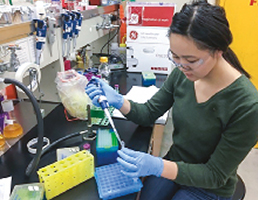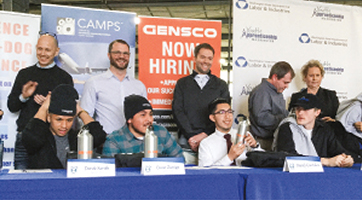Connecting High Schoolers to Apprenticeships
Type:
Article
Topics:
College- Career- and Life-Readiness,
School Administrator Magazine
August 01, 2018
Programs have moved beyond skilled trades to provide college and career prep in health sciences, information tech and more

But there was something else that stood out: Sophia was a youth apprentice.
During her junior year of high school, Sophia started the two-year biomedical youth apprenticeship program in a science laboratory at the University of Wisconsin-Madison. By the end, she completed 900 hours of paid work experience as a lab technician. She also completed four semesters of related classroom-based instruction, learning about concepts to help her on the job.
The two-year program was a commitment for Sophia and a commitment for her employer. This year, there are 22 other youth apprentices in the biotech youth apprenticeship spread across labs at the university. For the employers, the commitment of an apprenticeship makes it worthwhile.
As Professor Brian Fox, a biochemist, put it, “We like the commitment of having them for two years. It takes them a year to build some experience. But by the second year, they can be quite productive. … Our field is all about training — post-docs, grad students, college students. Why stop there?“
But what are they being trained for?
Balancing Commitments
Not all the biomedical youth apprentices will be Ivy League-bound, but according to Josh Fassl, who directs the youth apprenticeship program for the Dane County School Consortium in Monona, Wis., most youth apprentices plan to pursue postsecondary education. Sixty-five percent of the Dane County youth apprentices went on to a four-year college, and another 31 percent enrolled in a two-year college.Regardless of students’ post-high school plans, Fassl sees youth apprenticeships helping them prepare.
“Youth apprenticeship means students have to balance multiple commitments,” he says. “It forces students to problem solve, plan ahead and communicate priorities to adults, whether a teacher or a boss.”
Such skills are just the ones young people need to be successful for college and career. “Youth apprentices are resilient, something all students need no matter where they head next,” Fassl says.
That is promising for the 4,000-plus high school students statewide participating this year in Wisconsin’s Youth Apprenticeship Program, which offers programs across multiple career fields, including manufacturing, health sciences and information technology.
“Programs like youth apprenticeship hold us accountable as educators to support students to succeed in personalized ways,” adds Fassl, citing a new statewide requirement in Wisconsin for all schools to help students generate an academic and career plan as a prerequisite before students and their parents may consider an apprenticeship.
“Through youth apprenticeship, we can offer students a concrete way to deliver on their plan and do what we need to do as school leaders to make sure they have the coursework and flexibility to succeed in the program,” he says.
A Postsecondary Route

These traditional perceptions are based in some reality. Of the more than half million apprentices in the United States today, most still are in the skilled trades and manufacturing, and the average age of an apprentice in the U.S. remains closer to 30 than 18. But when it comes to apprenticeship, the United States is an outlier. In countries such as Germany and Switzerland, apprenticeship programs are found in a range of industry sectors, and apprentices in these countries are young and numerous. More than half of Swiss and German high school graduates start down an apprenticeship pathway as their first postsecondary step.
At a time when education leaders across the country are looking for strategies to prepare their students for both college and career, youth apprenticeship can be a valuable tool for districts to serve students, if employers are ready to partner. The timing may be right, too. Facing down aging workforces and tightening labor markets, employers are stepping up calls for educators to ensure students are career ready, a seemingly catchall term that can mean everything from teamwork and communication to a strong hand-shake. Youth apprenticeships respond to these concerns by demanding employers also step up.
Employer Backing
Because apprentices are always paid employees, employers need them to develop skills to be productive. In return, apprentices gain valuable work experience and access to professional mentors. In most programs, they also earn postsecondary credit and credentials, usually through a dual-enrollment scheme between a high school and a two-year college.Employers, in some cases, pick up that tab to get the level of customization they need from classroom-based learning. They also realize that offering free college credit is a likely draw for wooing students and parents.
But putting this all together is not easy. John Page, director of career technical education at Tacoma Public Schools in Washington, knows this firsthand. Starting in 2016, the Tacoma district partnered with the Aerospace Joint Apprenticeship Committee and Bates Technical College to launch a pilot youth apprenticeship program.
The district had to find solutions for several obstacles to make youth apprenticeships work. Students must have the time and flexibility to work, take college coursework and graduate on time. Employers, to justify their investment, might find meaningful skill-building for students in the workplace “beyond making copies or sweeping floors,” Page says. These programs need to combat myths about apprenticeships and clarify state policies around what teenagers may do in a workplace.
He maintains these are solvable issues. To Page, the hardest challenge for education leaders is to define what it means to be a partner. “Youth apprenticeship presents a unique opportunity to validate the learning of our students, but we cannot do it alone,” he says. “It takes time to build trust with other partners in our community.”
Intermediary Support
In Tacoma, the 10-year-old Aerospace Joint Apprenticeship Committee, consisting of employers and employees, has implemented registered apprenticeship programs based on industry needs. The committee serves as the medium for bringing the youth apprenticeship partners together.The apprenticeship committee exemplifies the common ingredient across American youth apprenticeship programs: the intermediary. Intermediaries help recruit employers and assist in setting up apprenticeship programs for youth. Intermediaries also work with high schools and colleges to recruit students, organize schedules and identify the fitting postsecondary coursework.
“A partner like AJAC knew all the right questions to ask, and it assured us as school leaders, it wasn’t up to us to have all the answers,” Page says. “Without AJAC, we just wouldn’t have the capacity to create this level of experience for our students and employer partners.”
Intermediaries come in many forms, and several states are exploring how to scale them to work with schools and employers to set up and run youth apprenticeships. One of the most ambitious efforts is in Colorado, where non-profit CareerWise Colorado was founded and is building off local success in the Denver Public Schools. CareerWise plans to serve 20,000 youth apprentices statewide in 10 years.

Lingering Questions
Despite the growing interest in youth apprenticeship, big questions remain. First and foremost is whether more American employers are willing to invest. Employers in the U.S. have grown accustomed to relying on the college degree, but demographic trends, including the aging of the workforce, and employer interest in increasing diversity lends new urgency to a different route.Second is the question of whether students and parents are ready to embrace youth apprenticeship. Recent research by New America as summarized in the report “Youth Apprenticeship in America Today: Connecting High School Students to Apprenticeship” suggests Americans are supportive, holding apprenticeships on par with four-year universities and community colleges as a viable way to prepare for a career. Growing anxieties over the cost of higher education and visible challenges related to completion of academic degrees and post-college employment seem to drive the public’s openness.
But if employers and families are ready, what about American education? In a world where schools are still accountable above all for proficiency on state learning standards and graduation, are policies and financial resources in place to ensure youth apprenticeship contributes to these goals? While several states found an opportunity within the Every Student Succeeds Act to promote and measure career readiness, this is only a start.
Finally, school leaders must wrestle with the challenging question of which students ought to be served by youth apprenticeship programs. Youth apprenticeship confronts deep equity challenges related to a history of tracking students within vocational education. At the same time, the emerging breed of youth apprenticeship programs today tends to be highly selective and competitive, which raises new equity concerns over who will ultimately access these lucrative opportunities.
Expansion Awaits
Despite these challenges, seeing the promise of programs like the one in Tacoma, Washington Gov. Jay Inslee, fresh off a visit to Switzerland, launched an expansion of youth apprenticeship across the state early in 2018. Maud Daudon, former head of the Seattle Chamber of Commerce, was tasked by Inslee with developing a 10-year vision.Daudon summed up the urgency when she accepted the assignment. “We have a lot of jobs in Washington state that are going unfilled or filled by talent from elsewhere. At the same time, not enough Washingtonians are fully participating in our economy and are being left behind,” she says. “With that, our motivation is clear.”
Ultimately the ability of youth apprenticeships to respond to such challenges will depend not on how well programs serve students bound for the Ivy League, but rather the broad swath of students today who are not finishing postsecondary education. Will apprenticeships give them the experiences to succeed in today’s economy?
From his perch overseeing the launch of youth apprenticeships in Tacoma, Page says he sees too much value in these programs to not try to expand them. “It’s incumbent upon us as education leaders to take risks and work to do big, new things for our students.” To him, given the possible rewards for students, employers and communities, youth apprenticeships are worth the work it takes.
Author
Additional Resources
“Youth Apprenticeship in America Today: Connecting High School Students to Apprenticeship” is a report by New America summarizing the potential and challenges for expanding youth apprenticeship for high school students.
Other informational resources suggested by Brent Parton are:
»Two recent reports by the U.S. Department of Education offering case studies of states and communities connecting high school students to apprenticeship: “Connecting Secondary Career and Technical Education and Registered Apprenticeship: A Profile of Six State Systems” and “Opportunities for Connecting Secondary Career and Technical Education Students and Apprenticeship Programs”
» The U.S. Department of Labor issued official guidance in 2017 on how to design registered apprenticeship programs to connect to high school students: “Framework on Registered Apprenticeship for High School Students”
» Nancy Hoffman and Robert Schwartz offer a detailed comparative study of the Swiss vocational education system, which is delivered through a youth apprenticeship model, in “Gold Standard: The Swiss Vocational Education and Training System”
“Youth Apprenticeship in America Today: Connecting High School Students to Apprenticeship” is a report by New America summarizing the potential and challenges for expanding youth apprenticeship for high school students.
Other informational resources suggested by Brent Parton are:
»Two recent reports by the U.S. Department of Education offering case studies of states and communities connecting high school students to apprenticeship: “Connecting Secondary Career and Technical Education and Registered Apprenticeship: A Profile of Six State Systems” and “Opportunities for Connecting Secondary Career and Technical Education Students and Apprenticeship Programs”
» The U.S. Department of Labor issued official guidance in 2017 on how to design registered apprenticeship programs to connect to high school students: “Framework on Registered Apprenticeship for High School Students”
» Nancy Hoffman and Robert Schwartz offer a detailed comparative study of the Swiss vocational education system, which is delivered through a youth apprenticeship model, in “Gold Standard: The Swiss Vocational Education and Training System”
Advertisement
Advertisement
Advertisement
Advertisement


